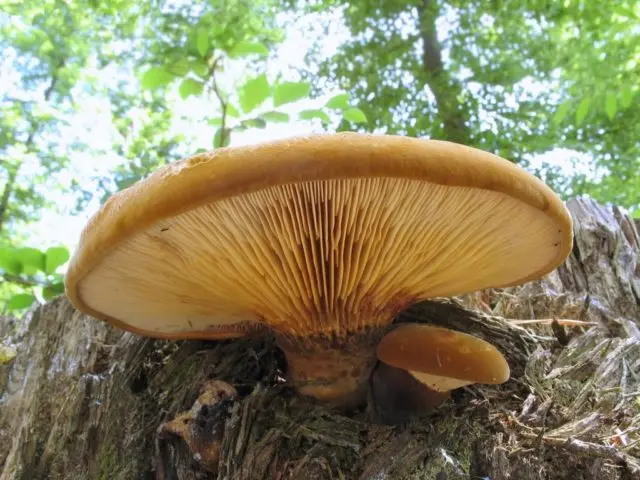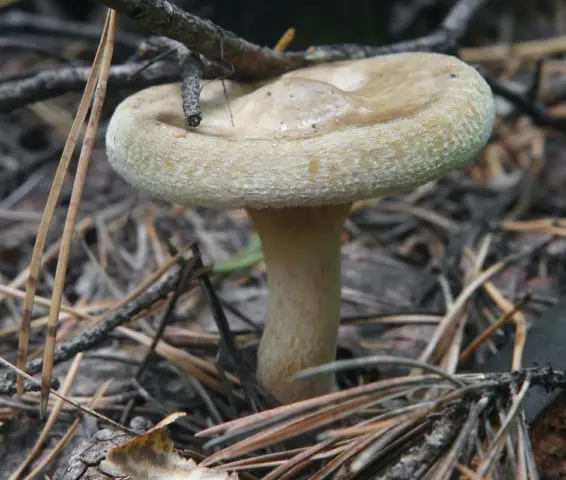Contents
The fat pig, belonging to the genus Tapinella, has long been considered a mushroom with low taste properties, which was eaten only after thorough soaking and boiling. After several cases of poisoning, scientists suggested that the mushroom has unexplored toxic properties, and did not recommend it for use. Despite this, many mushroom pickers still consider the fat pig to be a completely edible mushroom and continue to collect it. This should be done very carefully, as there are related species that are officially recognized as poisonous. A photo and description of a thick pig will help to identify the main signs of difference and not make a mistake in choosing.
Where does fat pig mushroom grow?
The fat pig is a resident of regions with a temperate climate. It is common in coniferous forests, a little less common in deciduous and mixed massifs. Favorite places of its growth are the roots and trunks of fallen trees, stumps overgrown with moss. The fungus settles in shady places, in lowlands and ravines. Pigs are arboreal saprotrophs that use dead wood as food, decomposing it into the simplest organic compounds. The fat pig lives in large colonies or singly. Its fruiting begins in the second half of summer and continues until the end of October.
What does a fat pig look like?

In numerous photos you can see what a fat or felt pig looks like. This is a hat-legged agaric fungus, which got its name because of the thick stem and the shape of the cap, quite thick and fleshy, reaching 30 cm in diameter. In young pigs, the cap is small, hemispherical. Gradually, it increases, becomes spatulate, with a depressed center and tucked edges. The young skin is felty to the touch, and over time it becomes smooth and dry, covered with cracks. The color of the cap is brown or dark orange, close to brown.
The hymenophore of the fungus consists of light, frequent plates that darken with age.
The leg of the thick pig reaches 10 cm in height and 5 cm in width, it has a dense pulp, covered with a felt coating. It grows, shifted to the edge of the cap, sometimes it is curved.
The fat pig has light flesh, odorless, with a bitter taste. It is hygrophane (swells under the influence of moisture in the external environment), and quickly darkens at a break.
About the features of the variety on a good example – in the video:
Edible or not fat pig
The thick-legged pig has a bitter and hard flesh. In Our Country, it was always classified as a low-quality mushroom and was eaten only as a last resort (if it was not possible to collect more valuable varieties of mushrooms). Later, it was classified as conditionally edible crops not recommended for consumption. The reason for this was the presence of unexplored toxic elements in it. Toxins have the peculiarity of gradually accumulating in the body with frequent use of the fungus in food. Contributed to the increase in harm from the use of fat pigs and the fact of deterioration of the general ecology of the planet. Many urban residents have recently observed and observed a decrease in immunity, and a growing susceptibility to allergic reactions.
Therefore, in 1981, the fat pig was excluded by the USSR Ministry of Health from the list of mushrooms allowed for harvesting.
In the presence of other, more valuable mushrooms, a fat pig should not be collected. If the mushroom is still planned to be eaten, then this should be done with great precautions in order to minimize possible harm to the body:
- do not use fat pig often and in large quantities;
- before cooking, soak the mushrooms for a day and boil twice for 30 minutes, changing the water;
- it is not recommended to eat dishes from fat pigs for people with diseases of the gastrointestinal tract and prone to allergic reactions;
- mushrooms should not be given to children, pregnant, lactating women, the elderly;
- this species should be collected only in areas with good ecology, away from busy highways and industrial enterprises;
- it is safer to eat young specimens.
How to tell the difference between thin and fat pigs
The most common counterpart of the fat pig is the thin pig, or cowshed, belonging to the Svinushkovye family.

The mushroom has long been considered edible, and it was even noted that it has good taste. But gradually, scientists came to the conclusion that it has pronounced toxic properties that do not appear immediately, but some time after consumption. Suspicions were confirmed after a severe poisoning with a fatal outcome. In 1944, the German mycologist Julius Schaeffer died of kidney failure, which developed two weeks after eating thin pork. This incident prompted scientists – mycologists to transfer the thin pig into the category of poisonous representatives prohibited for consumption. In our country, it was included in the list of poisonous and inedible mushrooms by a decree of the State Committee for Sanitary and Epidemiological Supervision of the Federation in 1993.
Pig fat and thin have significant differences. They need to be known in order to avoid severe poisoning. The felt pig is characterized by a thick leg and a dry hat. The thin pig looks a little different:
- a hat of its olive hue, up to 20 cm in diameter, does not crack, after rain it becomes sticky, slimy;
- leg – thin, cylindrical, has a matte surface, lighter than the cap or the same color with it;
- hymenophore – pseudolamellar, consists of brown folds, easily moves away from the cap;
- the flesh is pale yellow, often wormy, odorless and tasteless.
The cowshed contains the substance muscarine, an alkaloid of plant origin. When this poison enters the human body, the so-called muscarinic syndrome occurs. A person experiences increased salivation, vomiting and diarrhea begin, pupils constrict. In severe poisoning, collapse develops, pulmonary edema, ending in death.
The use of thin pork can cause a severe allergic reaction due to the presence of the so-called pig antigen in the fungus. This substance is deposited on the membranes of red blood cells, provoking an autoimmune reaction in a person. The antibodies produced are aggressive and damage not only fungal antigens, but also blood cell membranes. The result of the destruction of red blood cells is the developed renal failure. Painful condition does not come immediately. A negative reaction is formed over some time with the frequent and abundant use of this representative.
Svinushka actively accumulates heavy metals and radioisotopes from the air and soil, and their content in mushrooms is many times higher. This can also be the cause of severe poisoning, especially if the mushroom raw material was collected in an ecologically unfavorable area.
Application

After thorough soaking and boiling, the fat pig can be eaten fried, salted or pickled (hot pickling method). Like any mushroom, it is rich in fiber, contains a minimum of calories, is a source of vegetable protein, vitamins and minerals.
The content of valuable chemical elements in the composition of the product:
- Atromentin. This brown pigment is a natural broad-spectrum antibiotic and also prevents blood clots.
- polyporic acid. It has an antitumor effect.
- Telephoric acid – blue pigment Used for dyeing woolen fabrics. Gives them a beautiful, gray-blue hue.
Fat pig poisoning
The fat pig is considered a conditionally edible mushroom, so you need to eat it with great care. The toxic properties of the plant are not well understood, but if the rules for collection and preparation are violated, they can manifest themselves, causing severe poisoning.
- Improper heat treatment will cause all the toxins to remain in the mushrooms and enter the body.
- Too frequent use can lead to the accumulation of toxic elements in the body, which do not completely disappear even with thorough soaking and cooking of raw materials.
- Pigs fat have the ability to accumulate toxic substances from the environment. In specimens collected near the roadway, an increased amount of lead, cadmium and arsenic is recorded.
In case of poisoning, symptoms of damage to the gastrointestinal tract develop first of all: cutting pain in the epigastric region, vomiting, diarrhea. Then the composition of the blood is disturbed, the volume of urine excreted sharply decreases in the patient, and the level of hemoglobin rises. In severe cases, complications develop in the form of renal failure, acute respiratory failure, anaphylactic shock.
Conclusion
In mushroom reference books containing photos and descriptions of the fat pig, it is stated that you can collect and eat it if you do it with extreme caution. Some people have an individual intolerance to mushrooms, so you need to start using them with small portions, no more than once a day. They are the safest in salted and pickled form, since salt and acetic acid dissolve heavy metal compounds to some extent and bring them into solution.









